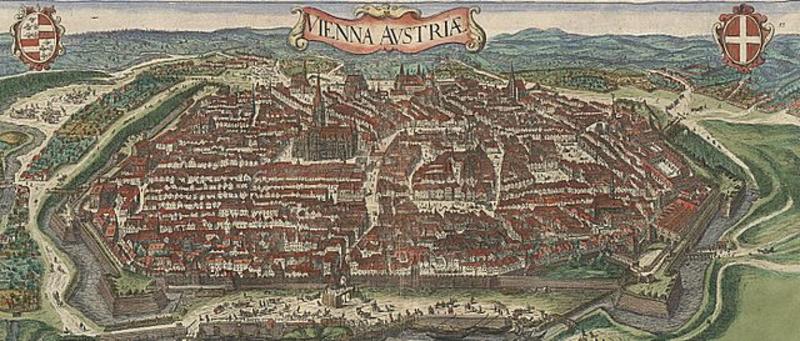Vienna
Vienna

The case-study on Vienna examines the fiscal-military networks running through a city which was not only the capital and courtly residence of the Austrian Habsburg monarchy but also a major economic centre within the Holy Roman Empire. Until and beyond the epoch-making Ottoman siege of 1683, Vienna also constituted a heavily fortified border city of the highest geostrategic importance. Yet far from stretching just into the territories of the Holy Roman Empire traditionally associated with the backing of the Habsburgs’ policies and the capitals of the latter’s varying western European allies, these manifold fiscal-military networks extended considerably into northern Italy, the Adriatic, the Balkans, Poland-Lithuania, and occasionally even into Russia so that this case study extends the project spatially into Southern and notably Eastern Europe.
The starting and ending points of the case study are connected to the rise of exceptionally successful figures of the business life of Vienna. Both Samuel Oppenheimer and the Rothschild family established a dominant position in the fiscal-military affairs of the Habsburg territories (and beyond) at times when Vienna was exposed to military operations. In 1683, Vienna was successfully defended from the Ottomans and the siege is also considered as the overture of the reconquest of large territories from the Ottoman Empire. Vienna’s merchant bankers and military contractors figure prominently during the late 17th and 18th century, especially during the nearly continuous warfare between 1683 and 1718. From 1688 the Habsburg monarchy was part of the ‘Grand Alliance’ against Louis XIV while at the same time emerging as a European great power out of its epic struggle with the Ottomans. The Jewish ‘court factor’ Samuel Oppenheimer, Vienna’s principal banker and military contractor, will be analysed as a major facilitator of the decisive external resource mobilisation the Habsburg monarchy was able to conduct during its ‘Age of Heroes’. The financial crash following Oppenheimer’s death in 1703 revealed the extent to which the Habsburg monarchy’s war effort depended on credit and resources procured from outside its own jurisdictions, and prompted wide-ranging administrative reforms as well as the foundation of the Viennese banking sector.
By tracing the fiscal-military networks of merchants, bankers, high-ranking military officers and diplomats and by considering Vienna not only as a major courtly residence, but also as an evolving diplomatic centre of the first decades of the eighteenth century, the study investigates the various cultural aspects of military contracting.
That the Habsburg court and the monarchy’s complex bureaucracy in Vienna formed crucial entrance points into fiscal-military networks which, however, necessitated skilful brokerage to liaise with is shown by the existence of specialised ‘regimental agents’ many German princes, who recruited significant proportions of the Habsburg army while securing rank-befitting military positions for their offspring, maintained in Vienna. Particular attention is paid to members of princely and aristocratic families as individual creditors and to the banking houses and firms involved in successive loan negotiations in the United Provinces, Germany, Italy and Switzerland.
The decades after the Silesian Wars are considered as a period of transformation, when the diversity of the banking services highlights Vienna’s diversity, where bankers and merchants of Swiss origin can coexist, compete, but occasionally cooperate with the emerging Greek Orthodox Sina family or with the Rothschilds who start their career as the financial managers of the Hessian “soldier trade”.
Finally, glancing at the implications of the dissolution of the Holy Roman Empire in 1806 accompanied by the loss of imperial jurisdiction and major territorial amendments, the Habsburg monarchy’s confrontation with Revolutionary France and the Napoleonic Empire will be taken into perspective in terms of a supposed ‘Austrofication’ of fiscal-military conduct and the beginning decline of the European fiscal-military system. The decades after the Congress of Vienna start with the foundation of the Austrian National Bank, but behind the institutional continuity, the bankruptcies and extinction of the formerly dominant merchant and banking families coincide with a more general transformation of the banking culture of the 1820s and 1830s.
Spanning over the period under research, the study traces a selection of further central aspects to the European fiscal-military system, like naval affairs exemplified by the multifarious, often underestimated, if not overlooked naval projects pursued by the Habsburgs which were heavily related to the mobilisation of strategic resources and expertise from abroad. The logistical challenges, yet also specific opportunities of alliance warfare, the management of imperial prerogatives and jurisdictions regarding recruiting, transit and garrison rights, billeting and contributions in the Holy Roman Empire and Imperial Italy as well as generally the peculiarities of mobilising external resources at Europe’s Eastern periphery form key questions of investigation.
Research Associate for the Vienna case study: Katalin Pataki.


